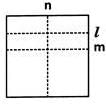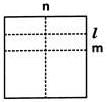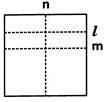Important Questions: Practical Geometry - Class 7 MCQ
20 Questions MCQ Test - Important Questions: Practical Geometry
Which among the following is used to construct a triangle?
In the given figure, find the measure of ∠ROT, if PQ=QR and ∠QPR=60o.

.

A triangular sign board is isosceles. If the unequal side is 7 cm and one of the equal sides is 6 cm, what is the measure of the third side?
Which of the following statements is incorrect?
In which of the following cases is the construction of a triangle not possible?
A Choose the correct option in which a triangle CANNOT be constructed with the given lengths of sides.
Direction: David folds a sheet of paper. The dotted lines as shown in the figure are the creases formed, which are named as l, m and n. Which of the following is true?
Which of the following is true?
Direction: David folds a sheet of paper. The dotted lines as shown in the figure are the creases formed, which are named as l, m and n.  What can you say about lines I and n?
What can you say about lines I and n?
Direction: David folds a sheet of paper. The dotted lines as shown in the figure are the creases formed, which are named as l, m and n.  What do you call the line n with respect to the lines I and m?
What do you call the line n with respect to the lines I and m?
Which of the following is used to draw a line parallel to a given line?
How many parallel lines can be drawn passing through a point not on the given line?
Based on the sides of a triangle, which of the following is a classification of triangles?
Which type of triangle is in the classification based on angles?
In which of the following cases can a triangle be constructed?
The measurements of ΔDEFare EF=8.4 cm, ∠E=103o and ∠F=85o. Which of the following is correct?
In ΔXYZ, x, y and z denote the three sides. Which of the following is incorrect'?
Which of the following can be used to construct a 30o angle?
Study the steps of construction given.
Step1: Draw a ray OA.
Step2: With O as centre and any convenient radius draw an arc MN to cut  at M.
at M.
Step3: With M as centre and the same radius draw an arc to cut MN at P.
Step4: With P as centre and the same radius, draw an arc to cut MN at Q.
Step5: Draw OQ and produce it to D. An angle AOD is constructed.
What is the measure of ∠AOD ?
Satish followed the steps given in the box.
Step 1: Construct an angle of 90∘.
Step 2: Bisect the 90∘ angle.
Step 3: Bisect one of the angles obtained in step 2.
Which steps is not required to construct a 45o angle?.





















